- Home
- Robert K. Massie
Peter the Great Page 2
Peter the Great Read online
Page 2
The Palace of Facets was primarily an official state building, and thus, in 1499, Ivan the Great ordered another palace of brick and stone in which to live. This five-story building, called the Terem Paiace, contained a honeycomb of low-ceilinged, vaulted apartments for himself and the many women—wives, widows, sisters, daughters—of the royal family. The building was badly damaged by fire several times during the sixteenth and early seventeenth centuries, but both of the first Romanov tsars, Michael and his son Alexis, lavished great efforts to restore the building. In Alexis' time, the doors, windows, parapets and cornices were made of white stone carved into foliage and figures of birds and animals, then painted bright colors. Alexis devoted special effort to refurbishing the fourth floor as a dwelling for himself. The five principal rooms—anteroom, throne room (known as the Golden Hall), study, bedroom and private chapel— were fitted with wooden walls and floors to prevent the dampness caused by moisture condensing on brick and stone, and the walls
were covered with hangings of embroidered silk, woolen tapestries or tooled leather, depicting scenes from the Old and New Testaments. The arches and ceilings were intersected by curving arabesques and Eastern versions of plants and fairy-tale birds, all done in brilliant colors with lavish inlays of silver and gold. The furnishing of the tsar's apartment was partly traditional and partly modern. The old, carved oaken benches and chests and polished wooden tables were there, but so also were upholstered armchairs, elaborate gilded and ebony tables, clocks, mirrors, portraits and bookcases filled with books of theology and history. One window of the tsar's study was known as the Petitioner's Window. Outside was a small box which could be lowered to the ground, stuffed with petitions and complaints, then raised to be read by the sovereign. The tsar's bedroom was upholstered with Venetian velvet and contained an intricately carved four-poster oak bed, curtained and canopied with brocade and silk and heaped with furs, eiderdown and cushions to ward off the ice currents of winter air that blasted against the windows and eddied under the doors. All these rooms were simultaneously heated and decorated by huge stoves of glazed, colored tiles whose radiant warmth also kept Russia's rulers warm.
The major drawback to these splendid chambers was their lack of light. Little sunlight could filter through the narrow windows with their double sheets of mica separated by strips of lead. Not only at night and on the short, gray days of winter, but even in summertime, most of the illumination in the Terem Palace came from the light of flickering candles in the alcoves and along the walls.
In the third quarter of the seventeenth century, the royal chambers were occupied by the second tsar of the Romanov dynasty, "the Great Lord, Tsar and Grand Duke, Alexis Mikhailovich, of all Great and Little and White Russia, Autocrat." Remote and inaccessible to his subjects, this august figure was enclosed in an aura of semi-divinity. An embassy of Englishmen, come in 1664 to thank the Tsar for his constant support of their once-exiled monarch, Charles II, was deeply impressed by the sight of Tsar Alexis seated on his throne:
The Tsar like a sparkling sun darted forth most sumptuous rays, being most magnificently placed upon his throne, with his scepter in his hand and having his crown on his head. His throne was of massy silver gilt, wrought curiously on top with several works and pyramids; and being seven or eight steps higher than the floor, it rendered the person of the Prince transcendently majestic. His crown (which he wore upon a cap lined with black sables) was covered quite over with precious stones, terminating toward the top in the form of a pyramid with a golden cross at the spire. The scepter guttered also all over with jewels, his vest was set with the like from the top to the bottom and his collar was answerable to the same.
From infancy, Russians had been taught to regard their ruler as an almost god-like creature. Their proverbs embodied this view: "Only God and the tsar know," "One-sun shines in heaven and the Russian tsar on earth," "Through God and the tsar, Russia is strong," "It is very high up to God; it is a very long way to the tsar."
Another proverb, "The sovereign is the father, the earth the mother," related the Russian's feeling for the tsar to his feeling for the land. The land, the earth, the motherland, "rodina," was feminine. Not the pure maiden, the virgin girl, but the eternal mature woman, the fertile mother. All Russians were her children. In a sense, long before communism, the Russian land was communal. It belonged to the tsar as father, but also to the people, his family. Its disposal belonged to the tsar—he could give away vast tracts to favored noblemen—yet it still remained the joint property of the national family. When it was threatened, all were willing to die for it.
The tsar, in this familial scheme, was the father, "Batushka," of the people. His autocratic rule was patriarchal. He addressed his subjects as his children and had the same unlimited power over them that a father has over his children. The Russian people could not imagine any limitation of the power of the tsar, "for how can a father's authority be limited except by God?" When he commanded, they obeyed for the same reason that when a father commands, the child must obey, without question. At times, obeisance before the tsar took on a slavish, Byzantine quality. Russian noblemen, when greeting or receiving favors from the tsar, prostrated themselves in front of him, touching the ground with their foreheads. When addressing his royal master, Artemon Matveev, who was Tsar Alexis' leading minister and close friend, declared, "We humbly beseech you, we your slave Artemushka Matveev, with the lowly worm, my son Adrushka, before the high throne of Your Royal Majesty, bowing our faces to the earth. . . ." In addressing the tsar, his whole lengthy official title had to be used. In so doing, the accidental omission of a single word could be considered an act of personal disrespect almost equivalent to treason. The tsar's own conversation was sacrosant: " "tis death for anyone to reveal what is spoken in the tsar's palace," declared an English resident.
In fact, the demi-god who bore these titles, who wore a crown braided with "tufts of diamonds as big as peas, resembling bunches of glittering grapes" and the imperial mantle embroidered with emeralds, pearls and gold, was a. relatively unassuming mortal. Tsar Alexis was recognized in his own time as "tishaishy tsar," the quietest, gentlest and most pious of all the tsars, and when he succeeded his father on the throne in 1645 at the age of sixteen, he was already known as "the Young Monk." In manhood, he grew taller than most Russians, about six feet, well built, inclined to fat. His roundish face was framed by light-brown hair, a mustache and a flowing brown beard. His eyes also were brown, their tone ranging from hardness in anger to warmth in affection and religious humility. "His Imperial Majesty is a goodly person, about two months older than King Charles II," reported his English physician, Dr. Samuel Collins, adding that his patron was "severe in his chastisements but very careful of his subjects' love. Being urged by a stranger to make it [punishable by] death for any man to desert his colors, he answered, 'It was a hard case to do that, for God has not given courage to all men alike.'"
Although he was tsar, Alexis' life inside the Kremlin was more like that of a monk. At four a.m., the Tsar threw aside his sable coverlet and stepped from his bed clad in shirt and drawers. He dressed and went immediately to the chapel next to his bedroom for twenty minutes of prayers and readings from devotional books. When he had kissed the icons and been sprinkled with holy water, he emerged and sent a chamberlain to bid the Tsaritsa good morning and ask after her health. A few minutes later, he went to her chamber to escort her to another chapel, where together they heard morning prayer and early mass.
Meanwhile, boyars, government officials and secretaries had gathered in a public anteroom awaiting the arrival of the Tsar from his private chambers. As soon as they saw "the bright eyes of the Tsar," they began to bow to the ground, some as many as thirty times, in gratitude for favors granted. For a while, Alexis listened to reports and petitions; then, at about nine a.m., the entire group went to hear a two-hour mass. During the service, however, the Tsar continued to converse quietly with his boyars, conducting public business and issuing instructions
. Alexis never missed any divine service. "If he be well, he goes to it," said Dr. Collins. "If sick, it comes to him in his chamber. On fast days he frequents midnight prayers, standing four, five, or six hours together, prostrating himself on the ground, sometimes a thousand times, and on great festivals, fifteen hundred."
Following morning mass, the Tsar returned to administrative work with his boyars and secretaries until time for dinner at noon.
He ate alone at a high table surrounded by boyars who dined at lower tables along the walls of the room. He was served only by special boyars, who tasted his food and sipped his wine before offering him the cup. Meals were gargantuan; on festival days, as many as seventy dishes might be served at the Tsar's table. Zakuski, or hors d'oeuvres, included raw vegetables, especially cucumbers, salted fish, bacon and innumerable pirozhki, sometimes stuffed with egg, fish, rice or cabbage and herbs instead of meat. Then came soups and roasts of beef, mutton and pork, seasoned with onions, garlic, saffron and pepper. There were dishes of game and fish such as salmon, sturgeon and sterlet. Dessert was cakes, cheeses, preserves, fruits. Russians drank mostly vodka, beer or a milder drink called kvas, made of fermented black bread, variously flavored with raspberry, cherry or other fruits.
But Alexis rarely touched any of the succulent dishes that were presented to him. Instead, he sent them as presents to various boyars to show special favor. His own palate was monastically simple. He only ate plain rye bread and drank light wine or beer, perhaps with a few drops of cinnamon added; cinnamon, Dr. Collins reported, was the "aroma imperiale." During periods of religious fasting, said Dr. Collins, the Tsar "eats but three meals a week; for the rest, he takes a piece of brown bread and salt, a pickled mushroom or cucumber and drinks a cup of small beer. He eats fish but twice in Lent and observes it seven weeks altogether. ... In fine, no monk is more observant of canonical hours than he is of fasts. We may reckon he fasts almost eight months in twelve."
Following dinner, the Tsar slept for three hours until time to return to church for vespers, again with his boyars, again to consult on affairs of state during the religious service. Supper and the end of the day were spent either with his family or with intimate friends playing backgammon or chess. Alexis' special pleasure during these hours was to listen to people read or tell stories. He liked hearing passages from books of church history, or the lives of saints, or the presentation of religious dogma, but he also liked to hear the reports of Russian ambassadors traveling abroad, extracts from foreign newspapers or simple tales told by pilgrims and wanderers who had been brought to the palace to entertain the monarch. In warmer weather, Alexis left the Kremlin to visit his country mansions outside Moscow. One of these at Preobrazhenskoe on the Yauza River was the center of Alexis' favorite sport, falconry. Over the years, the enthusiastic hunstman built up an immense establishment of 200 falconers, 3,000 falcons and 100,000 pigeons.
Most of the time, however, Alexis prayed and worked. He never questioned his own divinely granted right to rule; in his mind, he and all monarchs were chosen by God and responsible only to God.* Beneath the tsar stood the nobility, divided into almost a dozen ranks. The greatest noblemen held the highest rank, that of boyar, and were members of the old princely families who held hereditary landed estates. Below were the lesser aristocracy and gentry who had been given estates in return for service. There was a small middle class of merchants, artisans and other townspeople and then—the huge base of the pyramid—the peasants and serfs who made up the overwhelming mass of Russian society; their conditions of life and methods of farming were roughly similar to those of the serfs of medieval Europe. Most Muscovites used the title "boyar" to include all noblemen and high officials. Meanwhile, the actual daily work of administering the tsar's government was in the hands of between thirty and forty departments known as Prikazy. Generally speaking, they were inefficient, wasteful, overlapping, difficult to control and corrupt—in brief, a bureaucracy which nobody had designed and over which no one had any real control.
From his dimly lit, incense-scented Kremlin rooms and chapels, Tsar Alexis ruled the largest nation on earth. Vast plains, endless tracts of dark forest and boundless expanses of desert and tundra stretched from Poland to the Pacific. Nowhere in this immensity of space was the wide horizon broken by more than shallow mountains and rolling hills. The only natural barriers to movement on the broad plain were the rivers, and from the earliest times these had been converted into a network of watery highways. In the region around Moscow, four great rivers had their tributary headwaters: the Dneiper, the Don and the mighty Volga flowed south to the Black and Caspian seas; the Dyina flowed north to the Baltic and frozen Arctic.
Scattered over this immense landscape was a thin sprinkling of human beings. At the time of Peter's birth—near the end of Tsar Alexis' reign—the population of Russia was roughly eight million people. This was about the same as that of Russia's western neighbor, Poland, although the Russians were dispersed over a far
* When the English Parliamentarians cut off the head of King Charles I, in 1649, Tsar Alexis was so shocked and personally outraged that he expelled all English merchants from the interior of Russia, a move which gave great advantage to Dutch arid German merchants. While King Charles II remained in exile. Alexis sent him money and his tenderest wishes for "the disconsolate widow of that glorious martyr. King Charles 1."
greater area. It was much larger than the population of Sweden (less than two million) or England (slightly more than five million), but less than half that of the most populous and powerful state in Europe, the France of Louis XIV (nineteen million). A fraction of the Russian population lived in the old Russian towns—Nizhni-Novgorod, Moscow, Novgorod, Pskov, Vologda, Archangel, Yaroslavi, Rostov, Vladimir, Suzdal, Tver, Tula—and in the more recently acquired Kiev, Smolensk, Kazan and Astrachan. Most of the people lived on the land, where they wrenched a living from the earth, the forest and the waters.
Enormous though Alexis' tsardom was, Russia's boundaries were fragile and under pressure. In the east, under Ivan the Terrible and his successors, Muscovy had conquered the middle Volga and the khanate of Kazan, extending the Russian empire to Astrachan and the Caspian Sea. The Urals had been crossed and the immense, largely empty spaces of Siberia added to the tsar's domain. Russian pioneers had penetrated to the northern Pacific and established a few bleak settlements there, although a clash with the aggressive Manchu Dynasty of China had forced a withdrawal of Russian outposts along the Amur River.
To the west and the south, Russia was ringed by enemies who struggled to keep the giant landlocked and isolated. Sweden, then reigning as Mistress of the Baltic, stood guard across this seaborne route to the West. Westward lay Catholic Poland, the ancient enemy of Orthodox Russia. Only recently, Tsar Alexis had reconquered Smolensk from Poland, although that Russian fortress town lay a mere 150 miles from Moscow. Late in his reign, Alexis had won back from Poland the shining prize of Kiev, mother of all Russian cities and the birthplace of Russian Christianity. Kiev and the fertile regions both east and west of the Dnieper were the lands of the Cossacks. These were Orthodox people, originally vagabonds, freebooters and runaways who had fled the onerous conditions of life in old Muscovy to form bands of irregular cavalry and then to become pioneers, colonizing farms, villages and towns throughout the upper Ukraine. Gradually, this line of Cossack settlements was spreading southward, but the limits still were 300 or 400 miles above the shores of the Black Sea.
The ground in between, the famous black-earth steppe of the lower Ukraine, was empty. Here, tall grasses grew so high that sometimes only the head and shoulders of a man on horseback could be seen moving along above the grass. In Alexis' day, this steppe was the hunting and grazing ground of the Crimean Tatars, Islamic descendants of the old Mongol conquerors and vassals of the Ottoman sultan, who lived in villages along the slopes and among the| crags of the mountainous Crimean peninsula. Every
spring and summer, they brought their cattle and horses down to fee
d on the steppe grasslands. Often enough, they strapped on their bows, arrows and scimitars and rode north to raid and plunder among the Russian and Ukrainian villages, sometimes storming the wooden stockade of a town and leading the entire population off into slavery. These massive raids, bringing thousands of Russian slaves annually into the Ottoman slave markets, were a source of embarrassment and anguish to the tsars in the Kremlin. But there was nothing so far that anyone could do. Indeed, twice, in 1382 and 1571, that Tatars had sacked and burned Moscow itself.
Beyond the massive Kremlin battlements, beyond the gilt and blue onion domes and the wooden buildings of Moscow lay the fields and the forest, the true and eternal Russia. For centuries, everything had come from the forest, the deep, rich, virgin forest which stretched as far as an ocean. Amidst its birches and firs, its bushes and berries, its mosses and soft ferns, the Russian found most of what he needed for life. From the forest came the logs for his house and firewood for warmth, moss to chink his walls, bark for his shoes, fur for his clothing, wax for his candles, and meat, sweet honey, wild berries and mushrooms for his dinner. Through most of the year, the forest groves rang with the sound of axes. On lazy summer days, men, women and children searched beneath the dark trunks for mushrooms, or brushed through the high grasses and flowers to pick wild raspberries and red and black currants.
Russians are a communal people. They did not live alone deep in the forest, contesting the primeval weald with wolf and bear. Rather they chose to cluster in tiny villages built in forest clearings, or on the edges of lakes or the banks of slow-moving rivers. Russia was an empire of such villages: lost at the end of a dusty road, surrounded by pasture and meadowland, a collection of simple log houses centered on a church whose onion dome gathered up the prayers of the villagers and passed them along to heaven. Most of the houses had only a single room without a chimney; smoke from the fire burning inside the stove found its way outdoors as best it could, through cracks in the logs. Usually, as a result, everything and everyone inside was black with soot. For this reason, too, public baths were a common institution in Russia. Even the smallest village had its steaming bathhouse where men and women together could scrub themselves clean and then go outside, even in winter, to permit the wind to cool and dry their heated naked bodies.

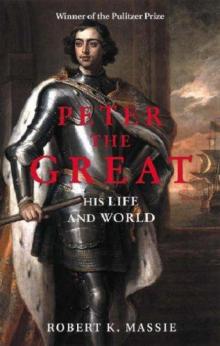 Peter the Great
Peter the Great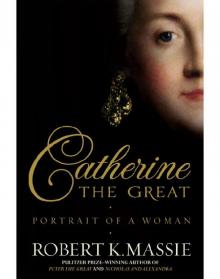 Catherine the Great
Catherine the Great Dreadnought
Dreadnought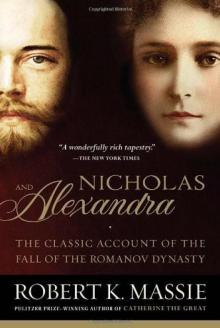 Nicholas and Alexandra: The Classic Account of the Fall of the Romanov Dynasty
Nicholas and Alexandra: The Classic Account of the Fall of the Romanov Dynasty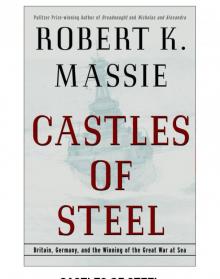 Castles of Steel
Castles of Steel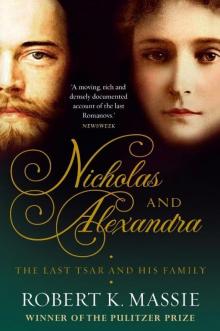 Nicholas and Alexandra: The Tragic, Compelling Story of the Last Tsar and his Family
Nicholas and Alexandra: The Tragic, Compelling Story of the Last Tsar and his Family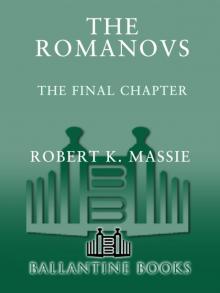 The Romanovs
The Romanovs Dreadnought, Britain, Germany and the Coming of the Great War
Dreadnought, Britain, Germany and the Coming of the Great War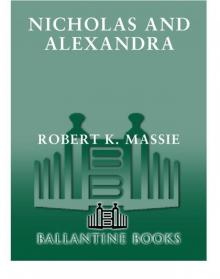 Nicholas and Alexandra
Nicholas and Alexandra